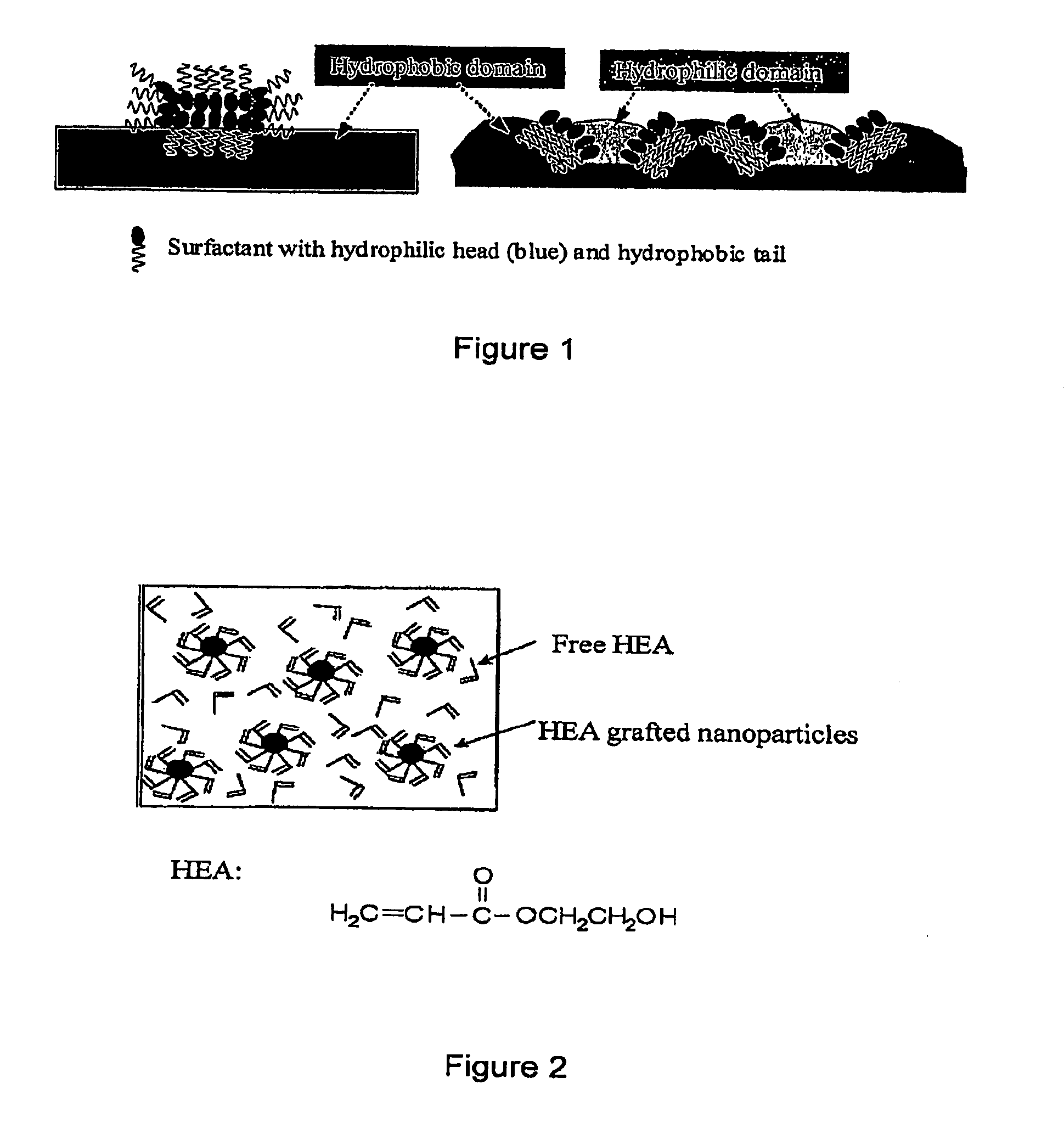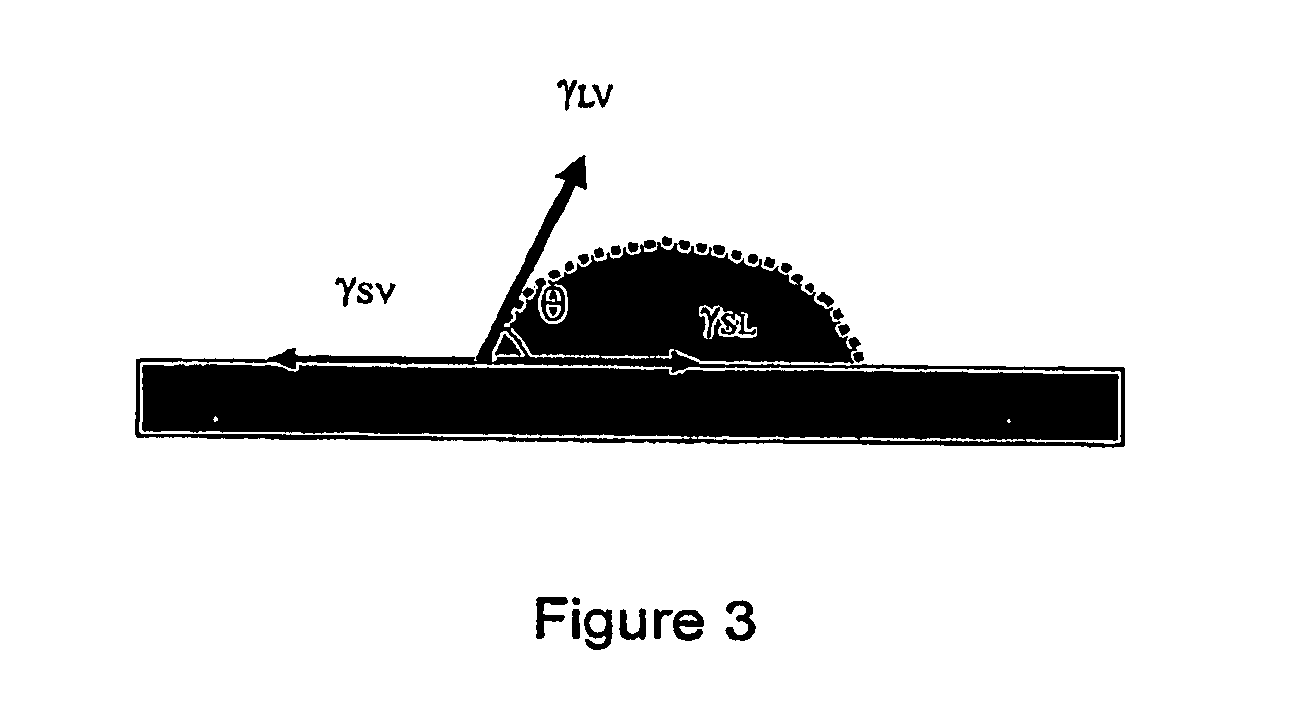Nanoengineered composite defog coating
a composite defog coating and nanotechnology technology, applied in the field of nanotechnology, can solve the problems of insufficient speed of diffusion absorption by diffusion, limited absorption capacity of coating thickness, and insufficient speed of diffusion absorption to prevent instant fogging in high humidity environment, etc., to achieve the effect of minimizing light scattering and high transparency
- Summary
- Abstract
- Description
- Claims
- Application Information
AI Technical Summary
Benefits of technology
Problems solved by technology
Method used
Image
Examples
example 1
[0059]In 6.0 grams Highlink OG 101-31 containing 30% silica nanoparticles in hydroxyethyl acrylate (Clariant), 2.0 grams 67% poly(ethylene glycol) acrylate (PEGA, average MW˜375) IPA solution, 1.2 grams 67% aliphatic urethane hexaacrylate (EM6145-100 from Eteral, Taiwan) IPA solution and 1.2 grams 67% bisphenol A glycerolate dimethacrylate IPA solution are added. 5% photo-initiator is added after the solution becomes completely clear. The coating solution is applied onto PET film by wire-bar and then cured with 200 WPI UV at 20 ft / min. The coating is clear and has sufficient hydrophilicity to prevent instantaneous fogging. The fogging time is 10-20 seconds when the coating is exposed to moisture generated from 80° C. hot water.
example 2
[0060]In 6.0 grams Highlink OG 101-31 containing 30% silica nanoparticle in hydroxyethyl acrylate (Clariant), 2.0 grams 67% poly(ethylene glycol) acrylate (PEGA, average MW˜375) IPA solution, 1.2 grams 67% allphatic urethane hexaacrylate (EM6145-100 from Eteral, Taiwan) IPA solution and 1.2 grams 67% bisphenol A glycerolate dimethacrylate IPA solution are added. Then 0.5 gram 20% Triton X-100 IPA solution is added. 5% photo-initiator is added after the solution becomes completely clear. The coating solution is applied onto a PET film by wire-bar and then cured with 200 WPI UV at 20 ft / min. Instead of fogging, clear water film forms on the coating surface when the coating is exposed to moisture generated from 80° C. hot water. Soaking the coating sample in 80° C. hot water for 5 minute degrades the AF effect of the coating without adding surfactant Triton-100, which fogs after exposing to moisture for 10˜20 seconds.
example 3
[0061]In 6.0 grams Highlink OG 101-31 containing 30% silica nanoparticle in hydroxyethyl acrylate (Clariant), 2.0 grams 67% poly(ethylene glycol) acrylate (PEGA, average MW˜375) IPA solution, 1.2 grams 67% aliphatic urethane hexaacrylate (EM6145-100 from Eteral, Taiwan) IPA solution and 1.2 grams 67% bisphenol A glycerolate dimethacrylate IPA solution are added. Then 0.4 gram 20% poly(ethylene glycol) monooleate (Mn ˜860) IPA solution is added. 5% photo-initiator is added after the solution becomes completely clear. The coating solution is applied onto a PET film by wire-bar and cured with 200 WPI UV at 20 ft / min. Instead of fogging, a clear water film forms on the coating surface when the coating is exposed to moisture generated from 80° C. hot water. The AF effect of the coating does not significantly change after the coating sample is soaked in water at room temperature or 80° C. hot water for 1 hour, which proves that the reactive surfactant is chemically anchored on the coating...
PUM
| Property | Measurement | Unit |
|---|---|---|
| Translucency | aaaaa | aaaaa |
| Transparency | aaaaa | aaaaa |
| Hydrophilicity | aaaaa | aaaaa |
Abstract
Description
Claims
Application Information
 Login to View More
Login to View More - R&D
- Intellectual Property
- Life Sciences
- Materials
- Tech Scout
- Unparalleled Data Quality
- Higher Quality Content
- 60% Fewer Hallucinations
Browse by: Latest US Patents, China's latest patents, Technical Efficacy Thesaurus, Application Domain, Technology Topic, Popular Technical Reports.
© 2025 PatSnap. All rights reserved.Legal|Privacy policy|Modern Slavery Act Transparency Statement|Sitemap|About US| Contact US: help@patsnap.com



